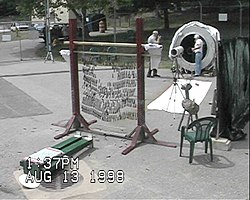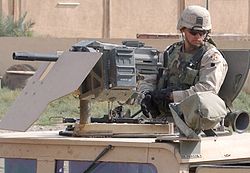Electrothermal-chemical (ETC) technology is an attempt to increase accuracy and muzzle energy of future tank, artillery, and close-in weapon system guns by improving the predictability and rate of expansion of propellants inside the barrel.

Non-lethal weapons, also called nonlethal weapons, less-lethal weapons, less-than-lethal weapons, non-deadly weapons, compliance weapons, or pain-inducing weapons are weapons intended to be less likely to kill a living target than conventional weapons such as knives and firearms with live ammunition. It is often understood that unintended or incidental casualties are risked wherever force is applied, however non-lethal weapons minimise the risk of casualties as much as possible. Non-lethal weapons are used in policing and combat situations to limit the escalation of conflict where employment of lethal force is prohibited or undesirable, where rules of engagement require minimum casualties, or where policy restricts the use of conventional force. However, these weapons occasionally cause serious injuries or death due to allergic reactions, improper use and/or other factors; for this reason the term "less-lethal" has been preferred by some organizations as it describes the risks of death more accurately than the term "non-lethal", which some have argued is a misnomer.
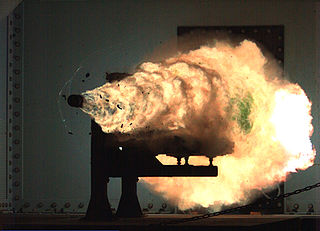
A railgun or rail gun is a linear motor device, typically designed as a weapon, that uses electromagnetic force to launch high-velocity projectiles. The projectile normally does not contain explosives, instead relying on the projectile's high kinetic energy to inflict damage. The railgun uses a pair of parallel conductors (rails), along which a sliding armature is accelerated by the electromagnetic effects of a current that flows down one rail, into the armature and then back along the other rail. It is based on principles similar to those of the homopolar motor.
Muzzle velocity is the speed of a projectile with respect to the muzzle at the moment it leaves the end of a gun's barrel. Firearm muzzle velocities range from approximately 120 m/s (390 ft/s) to 370 m/s (1,200 ft/s) in black powder muskets, to more than 1,200 m/s (3,900 ft/s) in modern rifles with high-velocity cartridges such as the .220 Swift and .204 Ruger, all the way to 1,700 m/s (5,600 ft/s) for tank guns firing kinetic energy penetrator ammunition. To simulate orbital debris impacts on spacecraft, NASA launches projectiles through light-gas guns at speeds up to 8,500 m/s (28,000 ft/s). FPS and MPH are the most common American measurements for bullets. Several factors, including the type of firearm, the cartridge, and the barrel length, determine the bullet's muzzle velocity.
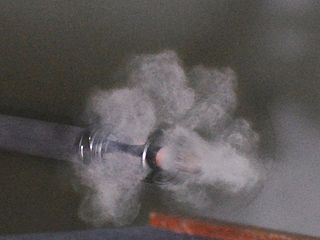
A flash suppressor, also known as a flash guard, flash eliminator, flash hider, or flash cone, is a muzzle device attached to the muzzle of a rifle that reduces its visible signature while firing by cooling or dispersing the burning gases that exit the muzzle, a phenomenon typical of carbine-length weapons. Its primary intent is to reduce the chances that the shooter will be blinded in low-light shooting conditions. Contrary to popular belief, it is only a minor secondary benefit if a flash suppressor reduces the intensity of the flash visible to the enemy.
Internal ballistics, a subfield of ballistics, is the study of the propulsion of a projectile.

The concept of a vortex engine or atmospheric vortex engine (AVE), independently proposed by Norman Louat and Louis M. Michaud, aims to replace large physical chimneys with a vortex of air created by a shorter, less-expensive structure. The AVE induces ground-level vorticity, resulting in a vortex similar to a naturally occurring landspout or waterspout.

The U.S. Army Combat Capabilities Development Command Army Research Laboratory is the U.S. Army's foundational research laboratory. ARL is headquartered at the Adelphi Laboratory Center (ALC) in Adelphi, Maryland. Its largest single site is at Aberdeen Proving Ground, Maryland. Other major ARL locations include Research Triangle Park, North Carolina, White Sands Missile Range, New Mexico, Graces Quarters, Maryland, and NASA's Glenn Research Center, Ohio and Langley Research Center, Virginia. ARL also has regional sites in Playa Vista, California, Chicago, Austin, TX, and Boston.

The United States Armed Forces has created a plethora of different types of 40 mm grenades in both the low-velocity 40×46 mm and high-velocity 40×53 mm calibers which uses what it calls a high-low propulsion system which keeps recoil forces within the boundaries of an infantry weapon. Presented on this page is a basic overview.

The ARL 44 was a French heavy tank and tank destroyer, the development of which started just before the end of the Second World War. Only sixty of these tanks were ever completed, from 1949 onwards. The type proved to be unsatisfactory and only entered limited service. The tank was phased out in 1953.
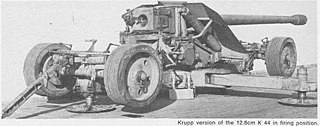
The 12.8 cm Pak 44 is a German anti-tank gun used during World War II. It was designed as a result of experiences on the Eastern front in 1943. The German Army came upon the Soviet 122 mm field guns and issued a requirement for a similar weapon. Development initially concentrated on a field gun known as the Kanone K 44. However, once heavier Soviet tanks such as the IS-2 started to appear, the design requirements were altered to include an anti-armour role.

A combustion light-gas gun (CLGG) is a projectile weapon that utilizes the explosive force of low molecular-weight combustible gases, such as hydrogen mixed with oxygen, as propellant. When the gases are ignited, they burn, expand and propel the projectile out of the barrel with higher efficiency relative to solid propellant and have achieved higher muzzle velocities in experiments. Combustion light-gas gun technology is one of the areas being explored in an attempt to achieve higher velocities from artillery to gain greater range. Conventional guns use solid propellants, usually nitrocellulose-based compounds, to develop the chamber pressures needed to accelerate the projectiles. CLGGs' gaseous propellants are able to increase the propellant's specific impulse. Therefore, hydrogen is typically the first choice; however, other propellants like methane can be used.
The Ballistic Research Laboratory (BRL) was a leading U.S. Army research establishment situated at Aberdeen Proving Ground, Maryland that specialized in ballistics as well as vulnerability and lethality analysis. BRL served as a major Army center for research and development in technologies related to weapon phenomena, armor, electronic devices, and high-speed computing. In 1992, BRL was disestablished and its mission, personnel, and facilities were incorporated into the newly created Army Research Laboratory (ARL).
The Laser Ignition in Guns, Howitzers and Tanks (LIGHT) Program began in the early 1990s at the Ballistic Research Laboratory (BRL), which later became a part of the U.S Army Research Laboratory (ARL). This program was designed to create laser ignition systems to replace the igniters in guns and artillery. Between 1993 and 1999, ARL did extensive research on laser ignition testing of solid propellants. During this time, the research conducted was a part of the LIGHT program.
The Third Arm Weapon Interface System (TAWIS), or Third Arm, is a passive, stabilizing device developed by the U.S. Army Research Laboratory (ARL) in 2016 to redistributes the weight of heavy firearms to make them easier to hold and carry. It weighs less than 1.8 kg, and consists of a mechanical appendage made out of carbon-fiber composite that has one end attached to a carbon fiber plate that fits inside an armor plate pocket and the other end attached to a Picatinny rail on top of the gun. It was to permit more accurate use of heavier weapons and reduce fatigue by displacing the weight of the weapon from their arms to their torso and mitigate firing recoil. As of 2018, the Third Arm is a prototype and is still in the testing phase of its development.
The Smart Weapon End-to-End Performance Model (SWEEPM) is a modeling software developed by the United States Army Research Laboratory (ARL), designed to measure the overall effectiveness of all types of munitions. SWEEPM was conceived in 2008 and completed in April 2013.
The SCORPION(Self CORrecting Projectile for Infantry OperatioN) program was a research initiative funded by the U.S. Defense Advanced Research Projects Agency (DARPA) and led by the U.S. Army Research Laboratory (ARL) and the Georgia Institute of Technology to integrate micro adaptive flow control (MAFC) technology into small caliber munitions to develop spinning, guided projectiles. The program led to the creation of a spin-stabilized 40 mm grenade, also called SCORPION, that could propel itself to its target by using calculated micro-jet bursts of air to correct its path once launched.
The Cannon-Caliber Electromagnetic Gun (CCEMG) launcher is a rapid-fire railgun launcher developed by the U.S. military in the early 1990s to study and test the viability of electromagnetic weapons.

The Next Generation Squad Weapon (NGSW) program is a United States military program created in 2017 by the U.S. Army to replace the 5.56mm M4 carbine, the M249 SAW light machine gun, and the 7.62mm M240 machine gun, with a common system of 6.8mm cartridges and to develop small arms fire-control systems for the new weapons.
The 75 SA 50 also called 75 Mle 50 or CN 75-50 is a French 75 mm high-velocity rifled gun. Although originally designed for the AMX-13 light tank, the SA 50 has also been used on the EBR wheeled reconnaissance vehicle and foreign medium tanks such as the Israeli upgraded Super Sherman.
